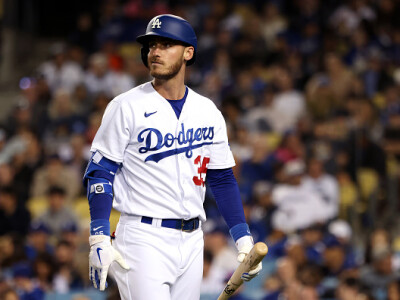Fantasy Baseball Player Spotlight: Can the Real Cody Bellinger Please Stand Up?

Cody Bellinger is into his sixth MLB season for the Los Angeles Dodgers, and few players have proven themselves to be more inconsistent from a fantasy perspective year over year. In Bellinger’s first three seasons, he looked like he could become one of the best hitters in baseball. He consistently stole ten bases or more in those three seasons, he hit over .300 in one season, he averaged 37 home runs per season in those first three years and he won the NL MVP in 2019. Then in his fourth season (2020), things somehow seemed to start to unravel a little bit for him. We are going to explore what has changed, what has been consistent, and what we should expect from Bellinger moving forward.
Launch Angle and Fly Ball Rates
For any batter to be successful over a long period of time, being consistent is paramount. Let’s take a look at Bellinger’s underlying numbers and see what he has kept consistent. First, let's look at his launch angle. Bellinger has always been a player known for his uppercut swing. In his rookie season, Bellinger had an average launch angle of 17.5 degrees. This launch angle leads to him putting the ball in the air 47.5 percent of the time and an infield flyball rate of 8.4 percent. When we look at his NL MVP season in 2019, we saw a similar launch angle at 17.9 degrees, but a slightly toned down flyball percentage at 42.4 percent and a similar infield flyball rate of 8.9 percent, and finally if we look at his disastrous 2021 season, he a launch angle of 22.2 percent, which lead to him putting the ball in the air 47.5 percent of the time and a disastrous 14.2 percent infield fly ball rate.
In these numbers, we see little change between his rookie season, and his MVP season just 3 years later, but in 2021 we saw the launch angle change, by nearly five percent, which not only increased his flyball rate, but it also blew up his infield fly ball rate leading to one in six balls he hit being an easy out in the infield. If you’re anything like me visualizing things like launch angles can be difficult, so if you look at the image below you can see the change. Bellinger as previously noted already had a swing that put the ball in the air but his increased launch angle only pushed that further.
The Statcast Numbers
Now that we have explored Bellinger’s launch angle, let’s take a look at some of his Statcast numbers to see how things like his exit velocity, barrel percentage, hard-hit percentage and plate discipline have changed as well.
When we look at the graphics below we are seeing how Bellinger ranked across the league. The more red the bubble, the higher to the right the number will be which indicates the higher percentile of the league that he placed. To keep things consistent, we will continue to look at his 2017, 2019, and 2021 seasons.
In his 2017 rookie season, we see that Bellinger had elite average exit velocity, maximum exit velocity, hard-hit percentage, barrel percentage, walk percentage and chase rate. He struggled with his strikeouts, likely due to his high whiff percentage. In 2019, we saw improvement across the board, even his elite numbers improved, while his whiff percentage improved dramatically, and with that, his strikeout percentage decreased dramatically as well going from the 15th percentile to the 78th percentile. When 2021 came though all of that seemed to disappear. Literally, every number came down, and not by a little bit, but a lot, even his average exit velocity which has been elite in the previous seasons was now average and his previously elite barrel percentage went all the way down to being in the bottom third of the league. Certainly, his launch angle change has something to do with those stark changes as his swing change will make barreling the ball more difficult, which will then affect his exit velocities along with his other numbers.
What to expect moving forward
While it would be very safe to say that we would love to get 2019 Cody Bellinger back, who was elite across the board, or even the 2017 version who was still a top-end hitter. Being realistic, for Bellinger to get back to that place in his career, he needs to get this swing back to where it was then.
The good news is that he has done it before, and he is just 26 years old, so you would like to imagine that he can still make those corrections and return to his previous elite level. The bad news is that swing changes can be very difficult to implement. They require a lot of repetition, and that can be difficult to do while you’re in the season due to the rigorous MLB schedule.
If you roster him this season, I would wait and see. We have seen some of that old Bellinger come out, and if you have someone who comes to you and makes a good offer for him, it wouldn’t be a terrible idea to let someone else deal with his ups and downs. Especially when you consider he didn’t cost you much draft capital. In a dynasty league, I might be more skeptical, yes he is still young but there is a lot of uncertainty, the upside is very much there, but there are no guarantees that he ever gets back to something that resembles 2019.
Related Links:
- Fantasy Baseball Daily Round Up
- MLB Injury Report
- MLB Weekly Waiver Advice
- Fantasy Baseball Closer Report
Player News
{{item.text}}
{{analysis.analysis}}

